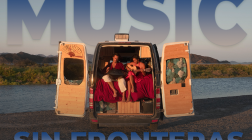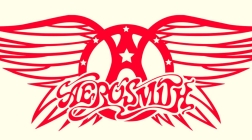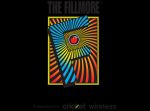Goodbye LA LA Land. Welcome Music Sin Fronteras. It’s still all music!

Today is name change day. And day change day.
I have been writing this column on Friday nights for 5 years under the title of LA LA Land because I was based in Los Angeles and covered music that was mostly in LA. But I moved to Mexico over two years ago, and while I still follow many LA bands and artists and visit and write up shows there, my focus is here at home in Mexico. So I will be covering the music all around me – which is from lots of places besides central Mexico and is in English and Spanish (and occasionally an indigenous language like Nahuatl), hence the new title Music Sin Fronteras – Music Without Borders. And I will post it Sunday instead of Friday.
I live in a Pueblo Magico called Ajijic (a Nahuatl word, not Spanish) in Jalisco state, central Mexico. There are 132 “Magic Towns” in Mexico, most designated that because of their beautiful colonial architecture and public art along with unique crafts. Not Ajijic. Not a Spanish colonial arch in sight. This is a pure Mexican town. What makes Ajijic magico is music, art, and lots of celebrations – all encased in a beautiful environment.
Ajijic is 4500 feet up in the mountains and about an hour from Guadalajara, the capital of the state of Jalisco. It looks out over Lake Chapala, Mexico’s largest lake, a little larger than Lake Tahoe in California. The lake and the handful of towns along its shore, which are collectively known as the Ribera, are surrounded by mountains, forests, and dormant volcanos, making it a dramatic and beautiful place to live. And it attracts musicians and artists by the boatload.
It helps that Ajijic is only an hour from Guadalajara, Mexico’s second-largest city and, to my mind, its creative musical capital. Guadalajara is a lot like LA; with a population of 5.26 million in the metropolitan zone, it is a little more than half the size of LA county. The city of Guadalajara is 1.35 million, about a quarter of LA’s population, but, the density of art and music is the same. From the International Mariachi Festival that draws 10,000 people a day and hundreds of bands to the International Latin music convention FIMPRO, to the Distrito Americana entertainment district which dwarfs Hollywood, there is music practically flowing down the streets (mixed with cerveza and tequila). And this doesn’t even count the recording studios, producers and bands, bands, bands.
These bands often come to Ajijic, and Ajijic artists play in Guadalajara. Bands visiting the Ribera join an interesting mixture of home-grown artists of all stripes and retired Expat musicians who have settled in Ajijic for the scenery, low cost of living, and environment. The gringo artists range from talented married couples singing country covers, to blues bands and singers with multiple albums and awards, to classical musicians from American and Canadian symphonies and big bands They mix with the many world-class Mexican musicians from Guadalajara (and Mexico City, and Veracruz, and Spain and all around Latin America) and play everything from American rock covers to fusion mariachi pop, to experimental jazz, to harp music from Veracruz to Peruvian xylophone with synth backup, to…you name it.
To this mix is added the other element of our little Pueblo Magico – non-stop celebration, fiestas, and parties.
Although Ajijic is a very sophisticated small town, many of whose residents have either lived or worked in the US or Europe or have relatives there, it is very rooted in tradition, both Catholic and Aztec. Every neighborhood has a patron saint, and every patron saint gets a parade, and every parade seems to end in a party with music and dancing. Add to that the numerous music venues and the touring shows that come to the bullring (no bulls for years) and the Auditoria, as well as the numerous holidays of Mexico, all of which require parades and music, and you have a village with non-stop music.
Then there are the Aztec and Folkloric and Mexican Flamenco dance troupes, the extended families that have passed down music and instruments for generations (one of which has created a large music school), and touring music groups from Mexico City and Puerto Vallarta. If you are a music critic, there are no days off!
I have been chronicling this incredible music environment for over a year now under the title of LA LA Land; starting today it will be titled Music Sin Fronteras. And I will post on Sundays to give me time to write about concerts I attend Friday or Saturday night in Ajijic or Guadalajara.
So like, comment, follow, and enjoy. And sip a little tequila while you read.
Next week: the festival of Michi. Three days of music, dance, and film to celebrate Michi-Cihualli, the goddess of Lake Chapala who commands the winds and the water and protects the lake from desecration and destruction.



























